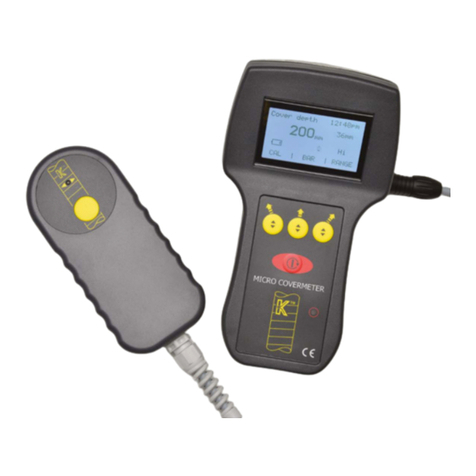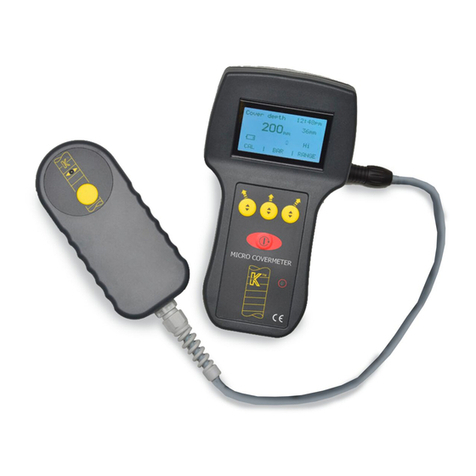
eventually show white. At this stage the stick-on baseplate
should be replaced to prevent damage to the probe housing
which may reduce the IP65 rating.
The Probe is correctly aligned over the rebar when the depth
reading is nearest to zero, or the tone of the Audio is at its
highest pitch if this function is switched on. The smaller
numbers referred to earlier as the signal strength may also
be noted and can be used to obtain a very precise
positioning of the probe. Note that at any time the size of the
bar being displayed on the screen can be changed by
pressing the middle Softkey above which is the word BAR.
If Data logging is taking place then when a strongest reading
is found, using the signal strength, indicating that the probe is
above the bar and positioned parallel with the axis of the bar,
then the yellow button on the K9 probe is pressed. At this
moment a floppy disc symbol will be displayed on the screen
above the Hi-Lo indicator to confirm that a reading has been
committed to the data log memory.
When the instrument leaves the factory it is usual that the
default setting of Hi will have been set and thus at CAL the
depth 200mm will be shown with the probe in air. If this has
been changed then the Lo setting will be indicated with a
reading of 120mm after CAL and with the probe in air. It must
be remembered that the last settings prior to the instrument
being switched off will remain in the memory and will be the
default settings until changed by the operator. The Hi-Lo
setting key can be selected at any time to enable the
searching to be refined to your requirements. It is not
necessary at this time to perform a further CAL. However it is
advisable to CAL whenever an important measurement is to
be made. The instrument calibrates both ranges in
succession and this can be noted on the display.
The K9 probe has a small red LED in the keypad. It will be
seen that this activates after the top dead centre of a bar
has been passed and the probe is moving away from the
bar. It can be used to aid the identification of the exact
position of the bar, though bars at the greater depths will not
act upon this feature as well as bars closer to the surface.
This LED feature taken together with the signal strength
reading and the depth display will be the best combined
method of locating a bar.
6. . AUTOMATIC BAR SIZING
During normal operation one press of the mode key will
bring up the bar size screen. Having used the previously
discussed searching techniques to locate the direction and
centre line of the bar you may now press the middle softkey
under the word Size and the instrument will perform an
automatic routine to estimate the size of the target bar. An
indication that the instrument is performing the calculation is
given and, providing always that an error message is not
shown, then a revised bar size will be displayed on this
screen accurate to one decimal point. Moving back to the
cover depth screen you will note that the bar size has been
up-dated to a whole number.
Errors that might be indicated will be that the bar being
targeted is either too near or too far for an accurate bar size
determination to take place.
7. PROBE SEARCHING METHODS
The K9 Probe is placed on the surface to be examined with
the circular keypad on the opposite face to that applied to
the surface, and thus visible. It is most convenient to have
the lead coming out of the Probe towards the operator so
that it lies under the wrist. The K9 Probe can then be moved
about on the surface until a reading is obtained. It is
recommended that the Hi setting be selected in order that
any bars within the range of the K9 probe may be detected.
When performing automatic bar sizing it may be found
desirable to change to the Lo setting to obtain a satisfactory
result. Then the Probe is rotated at this point until the
reading in the display is at the lowest number possible
(nearest to zero) which will indicate that the Probe is now
aligned with its longest face over the bar and with the bar
centrally positioned During the searching procedure
additional help can be obtained from either the pitch of the
audio if this feature has been selected, or by noting the
signal strength numbers arriving at the largest number when
directly over the bar and falling off towards zero when the
bar is passed. The red LED on the probe will also signal
when the top dead centre of the bar has been passed by
giving a brief indication as the probe moves away. On
sweeping back over the bar the LED again gives an
indication as the probe moves away, this time in the
opposite direction. Mark the point at which the indicators
suggest the top dead centre of the bar and now move the
probe along this axis to confirm the position of the bar.
Deflections may be found at points where bars at, say, 90
degrees are found. Mark these points for a later
examination. Now look for bars running parallel to the first
bar and gradually a grid can be drawn of the reinforcement.
10
12 13
11
8. SPECIFICATION OF K9 PROBE
Range 6mm bar 5 - 108 mm
40 mm bar 22 - 185 mm
Measurement is to the bar surface,
ignoring ribs
Accuracy 1mm up to60 mm
2mm up to 120 mm
3mm up to 160 mm
4mm above160 mm
Display Metric display is in whole millimetres.
Imperial display is in inches with 10ths
displayed.
Cover range 8mm to 22 mm minimum dependent on
for bar size bar diameter, although this can be
calculation overcome by the introduction of any spacer if
the bar is too close to the surface of the
concrete.
Bar size resolution is to 0,1 mm
6 mm bar - 60 mm maximum
40 mm bar - 80 mm maximum
Bar resolutionBar spacing resolution is dependent on bar size
and cover. Some examples of resolution
Performance
Bar diameterCoverMinimum bar spacing
16mm 60mm 70mm
16mm100mm110mm
25mm 130mm 150mm

























